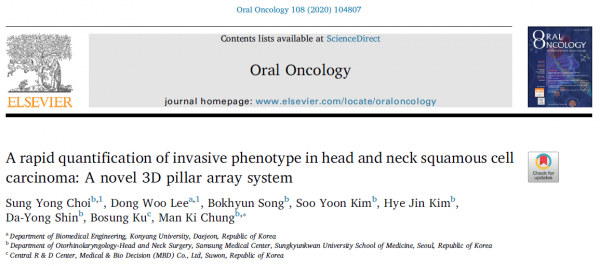Paper 2020, Oral Oncology, A rapid quantification of invasive phenotype in h…
Page Info

Contents
Background:
The widely used in vitro invasion assays for head and neck squamous cell carcinoma (HNSCC) are wound healing, transwell, and organotypic assays. However, these are still lab-intensive and time-consuming tasks. For the rapid detection and high throughput screening of invasiveness in 3D condition, we propose a novel spheroid invasion assay using commercially available pillar platform system. Materials and methods: Using the pillar-based spheroid invasion assay, migration and invasion was evaluated in three patient-derived cells (PDCs) of HNSCC. Immunofluorescence of live cells was used for the quantitative measurement of migratory and invaded cells attached to the pillar. Expression of epithelial-mesenchymal transition (EMT)-related gene (snai1/2) was measured by qRT-PCR. We also tested the impact of drug treatments (cisplatin, docetaxel) on the changes in the invasive phenotype.
Results:
All PDCs successfully formed spheroid at 4 days and can be measured invasiveness within 7 days. Intriguingly, one PDC (#1) obtained from the advanced stage showed robust migration, invasion and higher transcription of snai1/2, compared with the other two PDCs. Furthermore, the invasion ratio of the control spheroids was about 70% while the invasion ratios of drug-treated spheroids were lower than 50%, and the difference showed statistical significance (p < 0.01).
Conclusion:
The presented spheroid invasion assay using pillar array could be useful for the evaluation of cancer
cell behavior and physiology in response to diverse therapeutic drugs.
The widely used in vitro invasion assays for head and neck squamous cell carcinoma (HNSCC) are wound healing, transwell, and organotypic assays. However, these are still lab-intensive and time-consuming tasks. For the rapid detection and high throughput screening of invasiveness in 3D condition, we propose a novel spheroid invasion assay using commercially available pillar platform system. Materials and methods: Using the pillar-based spheroid invasion assay, migration and invasion was evaluated in three patient-derived cells (PDCs) of HNSCC. Immunofluorescence of live cells was used for the quantitative measurement of migratory and invaded cells attached to the pillar. Expression of epithelial-mesenchymal transition (EMT)-related gene (snai1/2) was measured by qRT-PCR. We also tested the impact of drug treatments (cisplatin, docetaxel) on the changes in the invasive phenotype.
Results:
All PDCs successfully formed spheroid at 4 days and can be measured invasiveness within 7 days. Intriguingly, one PDC (#1) obtained from the advanced stage showed robust migration, invasion and higher transcription of snai1/2, compared with the other two PDCs. Furthermore, the invasion ratio of the control spheroids was about 70% while the invasion ratios of drug-treated spheroids were lower than 50%, and the difference showed statistical significance (p < 0.01).
Conclusion:
The presented spheroid invasion assay using pillar array could be useful for the evaluation of cancer
cell behavior and physiology in response to diverse therapeutic drugs.

 2019, Molecules , A High Throughput Apoptosis Assay Using 3D Cultured Cells
2019, Molecules , A High Throughput Apoptosis Assay Using 3D Cultured Cells 2020, Medical Devices & Sensors, Three‐dimensional in vitro cell culture devices using patient‐derived cells for high‐throughput screening of drug combinations
2020, Medical Devices & Sensors, Three‐dimensional in vitro cell culture devices using patient‐derived cells for high‐throughput screening of drug combinations